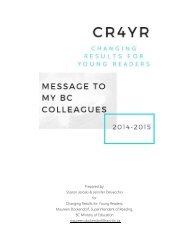Teacher
2015%20Nov-Dec%20Teacher%20low%20res
2015%20Nov-Dec%20Teacher%20low%20res
You also want an ePaper? Increase the reach of your titles
YUMPU automatically turns print PDFs into web optimized ePapers that Google loves.
The present:<br />
Shaping the new curriculum<br />
<strong>Teacher</strong>s were involved in drafting the<br />
new physical and health education (PHE)<br />
curriculum. It is their belief, along with the<br />
belief of the BCTF, that all students need safe,<br />
welcoming learning environments. Students<br />
must see themselves in all curricula, including<br />
PHE, and receive information that is accurate<br />
and up-to-date.<br />
Not having this information<br />
could have negative<br />
consequences for individual<br />
students, their current or<br />
future partners, and potentially<br />
for the health system and<br />
broader society.<br />
Like the previous curriculum, the new PHE will<br />
have primary students learn how to correctly<br />
identify body parts, including genitalia and<br />
sexual organs. Primary and intermediate<br />
students will also learn about recognizing<br />
and preventing abuse.<br />
As they do now, Grade 4 students will<br />
continue to learn about the bodily changes<br />
associated with puberty, and about human<br />
reproduction. AIDS and other sexually<br />
transmitted infections are also dealt with<br />
in later intermediate grades, along with<br />
new content: a direct reference to sexual<br />
orientation—a long-overdue addition.<br />
Students in the secondary grades are taught<br />
about sexual decision-making and consent.<br />
Classroom teachers are still responsible for<br />
delivering the new PHE curriculum, just as<br />
they are now. No provisions for opting-out<br />
of any provincial curriculum exist, including<br />
the sexual health education content found<br />
in PHE. Alternative delivery remains available<br />
as an option that parents can choose,<br />
but schools still have the responsibility of<br />
assessing the learning of each student for all<br />
aspects of the curriculum.<br />
New curriculum requires<br />
new in-service and Pro-D<br />
Too often, individual teachers do not<br />
have access to in-service or professional<br />
development opportunities on sexual<br />
health education that could give them the<br />
confidence to use language that is current,<br />
impart information that is accurate, or take<br />
into account what students already access<br />
online and through apps.<br />
Given the dearth of learning resources and<br />
in-service in many school districts, teachers<br />
often rely on the Internet to find information<br />
about sexual health education. Coupled<br />
with the lack of in-service and professional<br />
development opportunities some students<br />
end up graduating without getting the<br />
information they ought to receive. Not<br />
having this information could have negative<br />
consequences for individual students, their<br />
current or future partners, and potentially for<br />
the health system and broader society.<br />
The BCTF has told the Ministry of Education<br />
we are interested in collaborating with them<br />
to develop BC specific resources to support<br />
the sexual health education components of<br />
the new PHE curriculum.<br />
We have also expressed that we want to<br />
work with them to develop a plan to ensure<br />
that teachers who will teach the new PHE<br />
curriculum will have access to high-quality<br />
in-service and professional development<br />
opportunities in their school districts.<br />
In the end, it is simple: all students should<br />
have the right to learn what they need in<br />
order to make safe, wise choices—regardless<br />
of whether they self-identify as straight,<br />
lesbian, gay, bisexual, or transgender.<br />
Likewise, the information students receive<br />
must also reflect that diversity.<br />
What is<br />
ALTERNATIVE<br />
DELIVERY?<br />
Families who wish to address the current<br />
curriculum or the new physical and<br />
health education curriculum other than<br />
instruction by a teacher in a regular<br />
classroom setting may do so. This is<br />
not new. The Ministry’s long-standing<br />
alternative delivery policy provides<br />
students, with the consent of their<br />
parents or guardians and in consultation<br />
with their school, the opportunity to<br />
arrange mutually agreeable alternative<br />
means for addressing these learning<br />
outcomes. This might include home<br />
instruction with an agreed-upon package<br />
from the school, registration in a<br />
distributed learning course, self-directed<br />
studies, or in another way suggested by<br />
the school, parents, or student involved.<br />
This does not excuse students from having<br />
to meet the prescribed learning outcomes<br />
(or what is known in the new curriculum<br />
as the learning standards). Students<br />
whose families choose alternative<br />
delivery still need to be able to<br />
demonstrate to the school<br />
that they learned and<br />
understand the prescribed<br />
learning outcomes. Schools<br />
are responsible for<br />
assessment.<br />
© Wavebreakmedia/iStock<br />
November/December 2015 TEACHER 7



